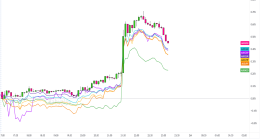
Opinions expressed by Entrepreneur contributors are their own.
According to Goldman Sachs, the economic stage for 2024 appears to be a bullish one, as it predicts an annual global GDP growth of 2.6%, which should buoy spirits if you’re a leader hoping for happy returns. Be careful, though: Growth and scaling aren’t always synonymous. If you have unrealistic expectations when it comes to the latter, you could well hamper the results of the former.
The simple fact is that the vast majority of companies don’t have an unlimited capacity to scale. At some point, rapid and unchecked growth can cause them to buckle and break in operation and logistics, which upends vision, brand and broader intentions.
At EOS Worldwide, we have a cultural ethos that everyone should fight for the greater good, which is seen in our core values, as well as in our focus and marketing strategy. Everyone moves forward because of that shared vision and care. And the payoffs go far: Team members feel confident in their purpose, as well as empowered because they know they’ve been chosen specifically for a unique set of talents. Scaling happens naturally as a result.
Related: 7 Ways To Scale Your Startup or Business
A solid foundation-vision
Among the critical considerations in avoiding overextension is determining which pace is uniquely right for you, certainly, but also that your vision be more than words.
Begin with a documented “North Star” concept to be embraced today, tomorrow and far into the future. Make it at once compelling and clear, and be certain that it resonates with all team members. If behaviors among some staff members aren’t aligning, for example, it might well be that vision training hasn’t been sufficient. This can be frustrating as you start to scale, which makes it an absolutely critical step.
Keep in mind, too, that instilling a vision effectively isn’t cheap in any sense: it means investing money, time and energy, and you might have to give up some efficiency in the process. There is, after all, an inherent inefficiency in driving toward a shared goal, because you need to make room for creativity and exploration.
Your vision also needs to be protected. It sets core values, and so it’s vital to avoid bending or breaking it in order to attain scaling ambitions. For example, one of our company’s core values is to “do the right thing.” Sounds disarmingly simple, but we make a point of following through on it via another core principle: “helping first.” This means that we train our teams to give without expecting anything in return. Again, this isn’t always efficient, but it keeps us grounded and consistent.
Related: Core Values: What They Are, Why They’re Important, and How to Implement Them Today
We’re still scaling, to be sure, but simply aren’t willing to sacrifice purpose, or to stray outside niche or core competencies. Consequently, our 10-year growth target is doable, because it has just enough dynamic tension to keep everyone stretching toward an ambitious objective while also having the right amount of “give” so the challenge doesn’t break everyone.
Has your company lost its way in an effort to scale without restraint? Then consider putting the following measures in place:
1. Break big “Rocks” into smaller ones
You likely already have one-, three- and 10-year targets. Perfect, but to make sure you’re moving in a steady and manageable direction, my suggestion is that you create something analogous to what we term at EOS Worldwide a 90-Day World™ and individual “Rocks” (objectives) therein. It’s a structure specifically designed to mark each quarter-year contribution towards annual goals and has resulted in measurably greater success.
Your version might include giving every team member a weekly scorecard that includes key tasks towards meeting 90-day expectations. It’s then the responsibility of managers to work to ensure employees are hitting scorecard numbers — making progress toward personal and company objectives. This process also keeps an organization from scaling too fast, as it’s a form of reverse engineering that starts with a broader vision: Nothing can suddenly get added (like a new product line) that doesn’t mesh with that mission focus.
2. Make sure you’ve got the right mix
Every person has two roles at work: the one they play today and the one they’ll play in the future. However, you can’t just scale big and hand out dozens of promotions in a year, or teams wind up feeling overwhelmed and unprepared.
So, employees need to be given the capacity, time and energy necessary to grow. For example, say you’ve mapped out an accountability chart that anticipates the staff knowledge and expertise you’ll need in one year or three years. Is the current team going to be the one to executive effectively? Do they have the capacity and resources?
Knowing the answers to these questions early means you can prepare accordingly, which might or might not include rearranging a team. In a 2021 survey, the Pew Research Center revealed that a stunning 63% of workers were ready to leave their employers because of a lack of promotional opportunities. This means that if you’ve hired the wrong people and can’t provide advancement, you owe it to them to either find a way to upskill or say goodbye in a respectful and responsible way that aligns with your vision.
Related: Builders and Boosters — A Leader’s Guide to Forming a Resilient Team
3. Let culture evolve organically
Another pitfall of scaling too quickly is an inability to maintain a preferred culture. To avoid a forced or brittle atmospheric shock during robust growth, it’s pivotal to treat company culture with intention, and patience.
Consider Starbucks and its scaling challenges, detailed in part in a Branding Strategy Insider article. It’s a powerhouse now, but it hit growth boundaries the hard way. For the first couple of decades, growth was modest, then came a flexion point where the company added 200-plus locations annually. As its former CEO, Howard Schultz, explained in his 2012 book, Onward: How Starbucks Fought for Its Life without Losing Its Soul (Rodale Books), the business scaled so quickly that it broke its ability to properly service customers. Their people could no longer create or control the desired experience, and the culture suffered. Fortunately, the now-35,000-plus-location colossus made this realization early and righted the ship.
Related: 3 Ways To Invest In Coffee, Other Than Drinking It
Infinite scaling may sound like the fast track to profitability, but it’s a unicorn dream: Don’t fall for that temptation. Instead, plan growth based on vision, people and culture. You’ll then operate with thoughtful restraint and be faced with fewer preventable problems.
This article is from Entrepreneur.com








